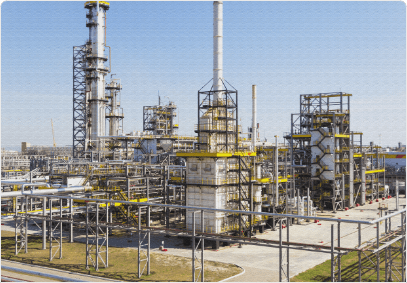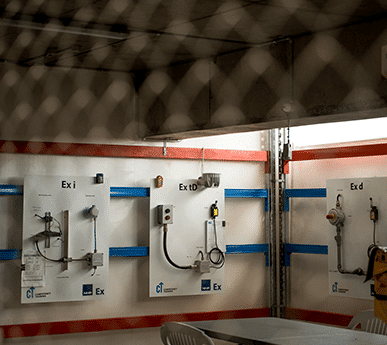All About Roar Solutions
All About Roar Solutions
Blog Article
Little Known Facts About Roar Solutions.
Table of ContentsNot known Details About Roar Solutions Some Known Details About Roar Solutions Not known Incorrect Statements About Roar Solutions
In such an environment a fire or explosion is possible when three basic conditions are met. This is commonly described as the "harmful area" or "burning" triangular. In order to safeguard setups from a prospective surge an approach of evaluating and identifying a potentially unsafe location is required. The function of this is to make sure the proper selection and installment of tools to eventually prevent an explosion and to make sure safety of life.
(https://www.edocr.com/v/kr2y9bbk/thomascarrillo4740/roar-solutions)
No equipment should be set up where the surface temperature level of the devices is more than the ignition temperature level of the given hazard. Below are some typical dust dangerous and their minimum ignition temperature. Coal Dirt 380C 225C Polythene 420C (thaws) Methyl Cellulose 420C 320C Starch 460C 435C Flour 490C 340C Sugar 490C 460C Grain Dust 510C 300C Phenolic Resin 530C > 450C Aluminium 590C > 450C PVC 700C > 450C Residue 810C 570C The chance of the danger being existing in a concentration high enough to create an ignition will vary from location to location.
In order to categorize this risk a setup is split right into locations of threat relying on the quantity of time the harmful exists. These locations are referred to as Zones. For gases and vapours and dusts and fibres there are three areas. Zone 0 Zone 20 A hazardous atmosphere is highly most likely to be existing and may exist for extended periods of time (> 1000 hours each year) or perhaps constantly Zone 1 Zone 21 A harmful environment is feasible yet unlikely to be present for lengthy durations of time (> 10 450 C [842 F] A category of T6 indicates the minimal ignition temperature is > 85 C [185 F] Dangerous area electric devices perhaps made for usage in greater ambient temperatures. This would certainly suggested on the rating plate e.g. EExe II C T3 Ta + 60C( This means at 60C ambient T3 will not be gone beyond) T1 T1, T2, T3, T4, T5, T6 T2 T2, T3, T4, T5, T6 T3 T3, T4, T5, T6 T4 T4, T5, T6 T5 T5, T6 T6 T6 A T Course ranking of T1 implies the optimum surface area temperature created by the instrument at 40 C is 450 C. Presuming the associated T Class and Temperature rating for the devices are ideal for the area, you can constantly utilize an instrument with a more stringent Department score than required for the area. There isn't a clear answer to this concern. It really does depend on the sort of equipment and what repairs require to be performed. Tools with certain test treatments that can't be carried out in the field in order to achieve/maintain 3rd party score. Should come back to the factory if it is prior to the equipment's service. Field Repair Service By Authorised Employee: Difficult testing may not be needed however specific procedures may need to be followed in order for the tools to preserve its 3rd event ranking. Authorised workers must be employed to do the work appropriately Repair work have to be a like for like replacement. New component must be taken into consideration as a straight substitute requiring no unique screening of the tools after the repair service is complete. Each piece of devices with a hazardous ranking need to be assessed independently. These are outlined at a high degree below, but also for even more comprehensive details, please refer straight to the standards.
The Best Strategy To Use For Roar Solutions
The devices register is a thorough data source of devices records that consists of a minimum collection of fields to recognize each product's area, technical criteria, Ex-spouse classification, age, and environmental data. This info is crucial for tracking and managing the devices efficiently within dangerous areas. In comparison, for periodic or RBI sampling evaluations, the quality will certainly be a combination of Comprehensive and Close evaluations. The ratio of Comprehensive to Shut assessments will be identified by the Devices Threat, which is analyzed based on ignition risk (the chance of a resource of ignition versus the probability of a flammable ambience )and the harmful location category
( Area 0, 1, or 2). This variation will certainly likewise influence the resourcing needs for job preparation. When Whole lots are specified, you can develop tasting plans based on the example size of each Whole lot, which refers to the variety of random equipment items to be examined. To determine the called for sample size, 2 aspects need to be reviewed: the size of the Great deal and the classification of evaluation, which suggests the level of effort that should be applied( reduced, typical, or enhanced )to the evaluation of the Great deal. By integrating the group of examination with the Whole lot dimension, you can then develop the suitable being rejected criteria for an example, meaning the allowable variety of faulty things found within that example. For more information on this procedure, please refer to the Power Institute Standards. The IEC 60079 conventional recommends that the optimum period between inspections must not surpass 3 years. EEHA inspections will additionally be carried out outside of RBI campaigns as part of scheduled upkeep and devices overhauls or repair work. These inspections can be credited towards the RBI example dimensions within the influenced Whole lots. EEHA inspections are performed to identify mistakes in electric equipment. A heavy scoring system is essential, as a single piece of devices might have multiple mistakes, each with differing levels of ignition danger. If the combined score of both examinations is much less than twice the fault rating, the Whole lot is deemed appropriate. If the Lot is still considered inappropriate, it needs to undergo a complete inspection or reason, which may cause stricter assessment procedures. Accepted Lot: The root causes of any faults are recognized. If an usual failure setting is located, additional devices may require examination and repair service. Faults are categorized by intensity( Safety and security, Integrity, Housekeeping ), guaranteeing that urgent issues are evaluated and dealt with quickly to minimize any influence on safety and security or procedures. The EEHA data source ought to track and tape the lifecycle of mistakes along with the corrective activities taken. Implementing a robust Risk-Based Inspection( RBI )technique is critical for making sure conformity and safety and security in managing Electric Tools in Hazardous Locations( EEHA) (Roar Solutions). Automated Fault Scoring and Lifecycle Monitoring: Effortlessly manage faults and track their lifecycle to improve assessment precision. The intro of this assistance for risk-based examination even more reinforces Inspectivity's position as a best-in-class option for regulatory compliance, in addition to for any kind of asset-centric assessment use instance. If you have an interest in finding out more, we welcome you to ask for a presentation and discover just how our option can change your EEHA monitoring processes.
Roar Solutions Can Be Fun For Anyone

In terms of explosive threat, a dangerous location is an atmosphere in which an explosive atmosphere exists (or might be anticipated to be existing) in amounts that require special safety measures for the building, installation and use devices. electrical refresher course. In this post we check out the difficulties faced in the workplace, the risk control actions, and the required competencies to work safely
It issues of modern-day life that we manufacture, save or handle a variety of gases or liquids that are deemed flammable, and an array of dirts that are considered flammable. These materials can, in certain conditions, develop explosive environments and these can have major and heartbreaking effects. The majority of us know with the fire triangle get rid of any one of the 3 elements and the fire can not happen, however what does this mean in the context of hazardous locations? When breaking this down into its most basic terms it is essentially: a combination of a particular quantity of launch or leak of a certain compound or material, combining with ambient oxygen, and the existence of a source of ignition.
In many circumstances, we can do little about the degrees of oxygen in the air, yet we can have considerable impact on resources of ignition, for instance electric equipment. Unsafe areas are documented on the harmful location classification illustration and are recognized on-site by the triangular "EX LOVER" sign. Right here, among other key info, areas are split right into three kinds relying on the threat, the likelihood and period that an eruptive environment will exist; Area 0 or 20 is considered one of the most unsafe and Zone 2 or 22 is deemed the least.
Report this page